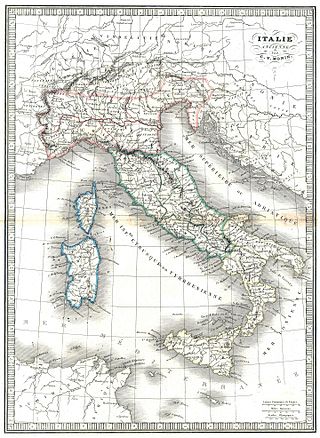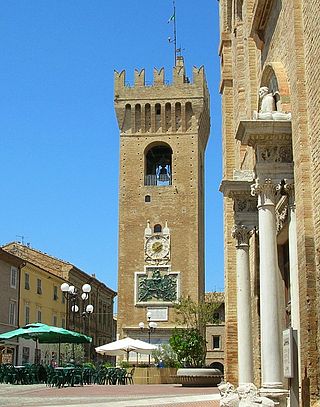
Pope Clement VIII, born Ippolito Aldobrandini, was head of the Catholic Church and ruler of the Papal States from 2 February 1592 to his death, in March 1605.

Pope Gregory IX was head of the Catholic Church and the ruler of the Papal States from 19 March 1227 until his death in 1241. He is known for issuing the Decretales and instituting the Papal Inquisition, in response to the failures of the episcopal inquisitions established during the time of Pope Lucius III, by means of the papal bull Ad abolendam, issued in 1184.

Pope Eugene IV, born Gabriele Condulmer, was head of the Catholic Church and ruler of the Papal States from 11 March 1431 to his death, in February 1447. Condulmer was a Venetian, and a nephew of Pope Gregory XII. In 1431, he was elected pope.

Pope Paul IV, born Gian Pietro Carafa, was head of the Catholic Church and ruler of the Papal States from 23 May 1555 to his death, in August 1559. While serving as papal nuncio in Spain, he developed an anti-Spanish outlook that later coloured his papacy. In response to an invasion of part of the Papal States by Spain during his papacy, he called for a French military intervention. After a defeat of the French and with Spanish troops at the edge of Rome, the Papacy and Spain reached a compromise: French and Spanish forces left the Papal States and the Pope thereafter adopted a neutral stance between France and Spain.

The Roman Ghetto or Ghetto of Rome was a Jewish ghetto established in 1555 in the Rione Sant'Angelo, in Rome, Italy, in the area surrounded by present-day Via del Portico d'Ottavia, Lungotevere dei Cenci, Via del Progresso and Via di Santa Maria del Pianto, close to the River Tiber and the Theatre of Marcellus. With the exception of brief periods under Napoleon from 1808 to 1815 and under the Roman Republics of 1798–99 and 1849, the ghetto of Rome was controlled by the papacy until the capture of Rome in 1870.

The history of the Jews in Italy spans more than two thousand years to the present. The Jewish presence in Italy dates to the pre-Christian Roman period and has continued, despite periods of extreme persecution and expulsions, until the present. As of 2019, the estimated core Jewish population in Italy numbers around 45,000.

Cum nimis absurdum was a papal bull issued by Pope Paul IV dated 14 July 1555. It takes its name from its first words:
Since it is absurd and utterly inconvenient that the Jews, who through their own fault were condemned by God to eternal slavery, can under the pretext that pious Christians must accept them and sustain their habitation, are so ungrateful to Christians, as, instead of thanks for gracious treatment, they return contumely, and among themselves, instead of the slavery, which they deserve, they manage to claim superiority: we, who newly learned that these very Jews have insolently invaded our City Rome and a number of the Papal States, territories and domains their impudence increased so much that they dare not only to live amongst the Christian people, but also in the vicinity of the churches without any difference of dressing, and even that they rent houses in the main streets and squares, buy and hold immovable property, engage maids, nurses and other Christian servants, and commit other and numerous misdeeds with shame and contempt of the Christian name. Considering that the Church of Rome tolerates these very Jews evidence of the true Christian faith and to this end [we declare]: that they, won over by the piety and kindness of the See, should at long last recognize their erroneous ways, and should lose no time in seeing the true light of the catholic faith, and thus to agree that while they persist in their errors, realizing that they are slaves because of their deeds, whereas Christians have been freed through our Lord God Jesus Christ, and that it is iniquitous for it to appear that the sons of free women serve the sons of maids.

Recanati is a comune (municipality) in the province of Macerata, in the Italian region of Marche. Recanati was founded around 1150 AD from three pre-existing castles. In 1290 it proclaimed itself an independent republic and, in the 15th century, was famous for its international fair. In March 1798 it was conquered by Napoleon.

The Spring of Bandusium is a natural water source in rural Italy, to which the Roman poet Horace addressed a well-known ode. The location is thought to be the site of poet's beloved Sabine farm in what is now the commune of Licenza. In the poem Horace promises to sacrifice a young goat to the spring and praises the spring's constancy in the hottest days of summer. The poem ends with Horace promising to immortalize the spring through his song.

Beginning with the invasion of Poland during World War II, the Nazi regime set up ghettos across German-occupied Eastern Europe in order to segregate and confine Jews, and sometimes Romani people, into small sections of towns and cities furthering their exploitation. In German documents, and signage at ghetto entrances, the Nazis usually referred to them as Jüdischer Wohnbezirk or Wohngebiet der Juden, both of which translate as the Jewish Quarter. There were several distinct types including open ghettos, closed ghettos, work, transit, and destruction ghettos, as defined by the Holocaust historians. In a number of cases, they were the place of Jewish underground resistance against the German occupation, known collectively as the ghetto uprisings.

The Alexians, officially named as the Congregation of Alexian Brothers, abbreviated C.F.A., is a Catholic lay religious congregation of Pontifical Right for men specifically devoted to caring for the sick which has its origin in Europe at the time of the Black Death. They follow the Augustinian rule.

In the early modern era, European Jews were confined to ghettos and placed under strict regulations as well as restrictions in many European cities. The character of ghettos fluctuated over the centuries. In some cases, they comprised a Jewish quarter, the area of a city traditionally inhabited by Jews. In many instances, ghettos were places of terrible poverty and during periods of population growth, ghettos had narrow streets and small, crowded houses. Residents had their own justice system. Around the ghetto stood walls that, during pogroms, were closed from inside to protect the community, but from the outside during Christmas, Pesach, and Easter Week to prevent the Jews from leaving at those times.
Notable things that happened in Ireland in 1555.
The 1153 papal election followed the death of Pope Eugene III and resulted in the election of Pope Anastasius IV.
The history of the Jews in Ancona in Italy, began when Jews settled into the city in the first half of the 14th century, contributing to money-lending and other economic roles.
Cum saepe accidere was a papal bull issued by Pope Clement VIII on 28 February 1592, which decreed that the Jews of Avignon were forbidden to trade "new commodities" in public places in order to put them at an economic disadvantage.

The Jewish Museum of Rome is situated in the basement of the Great Synagogue of Rome and offers both information on the Jewish presence in Rome since the second century BCE and a large collection of works of art produced by the Jewish community. A visit to the museum includes a guided tour of the Great Synagogue and of the smaller Spanish Synagogue in the same complex.

Pope Benedict XIV promulgated the papal bull Postremo mense on 28 February 1747. Like all other papal bulls, it takes its name from its incipit, Postremo mense superioris anni. The bull restated and developed certain aspects of Catholic Church teaching on baptising Jewish children without parental consent and the forcible removal of baptised Jewish children from their families.

Cum almam nostram urbem is a papal bull issued by Pope Pius II on 28 April 1462 prohibiting the destruction or removal of the ancient ruins in Rome and Campagna and the burning of ancient marble for lime. Anyone who damaged the ruins would be excommunicated. The bull begun: "Since we desire to preserve our beloved city in her dignity and splendour...".














